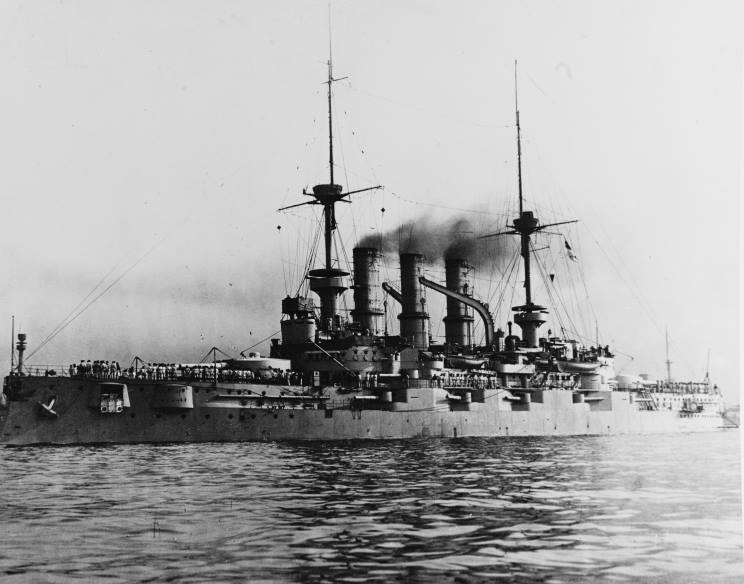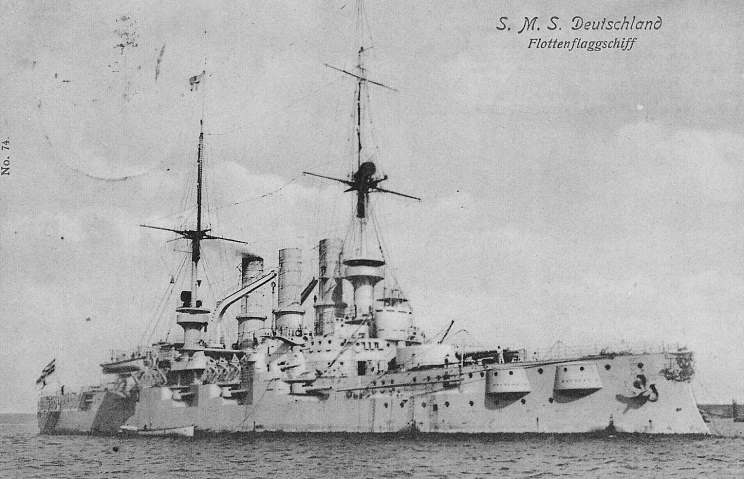German Pre-Dreadnought Battleship SMS Deutschland
SMS Deutschland was the lead ship of the Deutschland-class pre-dreadnought battleships (along with her sisters Schlesien, Schleswig-Holstein, Pommern, and Hannover) of the Imperial German Navy. She was laid down at Germaniawerft in Kiel in 1903, launched in November 1904, and commissioned in August 1906. The class was the last series of German pre-dreadnoughts, comprising Deutschland, Hannover, Pommern, Schlesien, and Schleswig-Holstein.
When completed, Deutschland was already overshadowed by HMS Dreadnought, launched the same year. Nonetheless, she and her sisters formed the backbone of the High Seas Fleet’s II Battle Squadron during the early years of the First World War.
Deutschland displaced just under 14,000 tons at full load and was armed with four 28 cm (11 in) SK L/40 main guns in two twin turrets fore and aft. Her secondary battery consisted of fourteen 17 cm (6.7 in) guns, supported by lighter 8.8 cm weapons for defence against torpedo craft, and six submerged torpedo tubes. Protection was considerable for a ship of her generation, with a 225 mm (8.9 in) belt and 280 mm (11 in) armour on the main turrets. She could make a maximum speed of around 18 knots, powered by three triple-expansion engines fed by twelve coal-fired boilers.
During peacetime before 1914, Deutschland served as flagship of the fleet until replaced by the dreadnought Nassau. She participated in the usual programme of training cruises, fleet manoeuvres, and diplomatic visits, strengthening Germany’s naval prestige.
At the outbreak of the First World War, Deutschland and her sisters were mobilised as II Battle Squadron. Although obsolete compared to dreadnoughts, they were still used for patrols in the North Sea and Baltic. In the Battle of Jutland (31 May–1 June 1916), Deutschland and the rest of II Squadron were assigned to the rear of the German line. Owing to their slow speed and vulnerability, they were kept out of the main action and saw little fighting. Late on the first day of the battle, Deutschland and the other pre-dreadnoughts briefly engaged several British battlecruisers before retreating. Their presence, however, tied down German resources, as they were a liability in any fleet action against the faster British Grand Fleet.
After Jutland, Deutschland and the other pre-dreadnoughts of II Squadron were withdrawn from front-line service. Deutschland became a guard ship and was later disarmed and used depot ship as the navy concentrated on its more modern dreadnoughts and battlecruisers.
Following the Armistice in 1918, Deutschland was struck from the naval register in March 1920 under the terms of the Treaty of Versailles. She was broken up for scrap in 1922–23.
Specifications of SMS Deutschland (Deutschland-class)
- Type: Pre-dreadnought battleship
- Displacement: 13,191 t (standard); 14,218 t (full load)
- Length: 127.6 m (418 ft 8 in)
- Beam: 22.2 m (72 ft 10 in)
- Draft: 8.21 m (26 ft 11 in)
- Propulsion: 3 × triple-expansion steam engines, 12 coal-fired boilers, 16,000 ihp
- Speed: 18 knots (33 km/h)
- Range: 4,800 nmi (8,900 km) at 10 knots
- Crew: 35 officers, 708 enlisted men (approx.)
- Armament:
- 4 × 28 cm (11 in) SK L/40 guns (2 × twin turrets)
- 14 × 17 cm (6.7 in) SK L/40 guns
- 22 × 8.8 cm (3.5 in) SK L/35 guns
- 6 × 45 cm (17.7 in) torpedo tubes (submerged)
- Armour:
- Belt: 225 mm (8.9 in)
- Main turrets: 280 mm (11 in)





